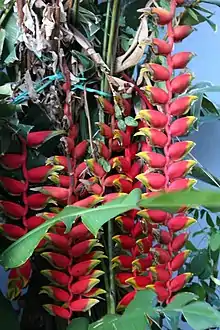Heliconia rostrata
Heliconia rostrata, the hanging lobster claw or false bird of paradise, is a herbaceous perennial plant native to El Salvador, Peru, Bolivia, Colombia, Venezuela, Costa Rica, and Ecuador, and naturalized in Puerto Rico.[2] Other heliconias grow in an upright position (e.g. Heliconia bihai), their cup-shaped flower bracts storing water for birds and insects. This plant, however, has downward-facing flowers, the flowers thus providing a source of nectar to birds.[3][4]
| Heliconia rostrata | |
|---|---|
 | |
| Lobster claws flower at peak season, Udumalpet, India | |
| Scientific classification | |
| Kingdom: | Plantae |
| Clade: | Tracheophytes |
| Clade: | Angiosperms |
| Clade: | Monocots |
| Clade: | Commelinids |
| Order: | Zingiberales |
| Family: | Heliconiaceae |
| Genus: | Heliconia |
| Species: | H. rostrata |
| Binomial name | |
| Heliconia rostrata Ruiz & Pavon | |
| Synonyms[1] | |
| |
Heliconias are known to those who grow them as a host flower to many birds, especially the hummingbirds. Because of its unique characteristics, it is often used as a specimen for tropical gardens.
Along with the Kantuta flower, Heliconia rostrata, known as patujú, is the national flower of Bolivia.
Gallery
References
- The Plant List, Heliconia rostrata
- Kew World Checklist of Selected Plant Families, Heliconia rostrata
- Ruiz López, Hipólito & Pavón, José Antonio. 1802. Flora Peruviana, et Chilensis 3: 71, t. 305, Heliconia rostrata
- Brako, L. & J. L. Zarucchi. (eds.) 1993. Catalogue of the Flowering Plants and Gymnosperms of Peru. Monographs in systematic botany from the Missouri Botanical Garden 45: i–xl, 1–1286.
